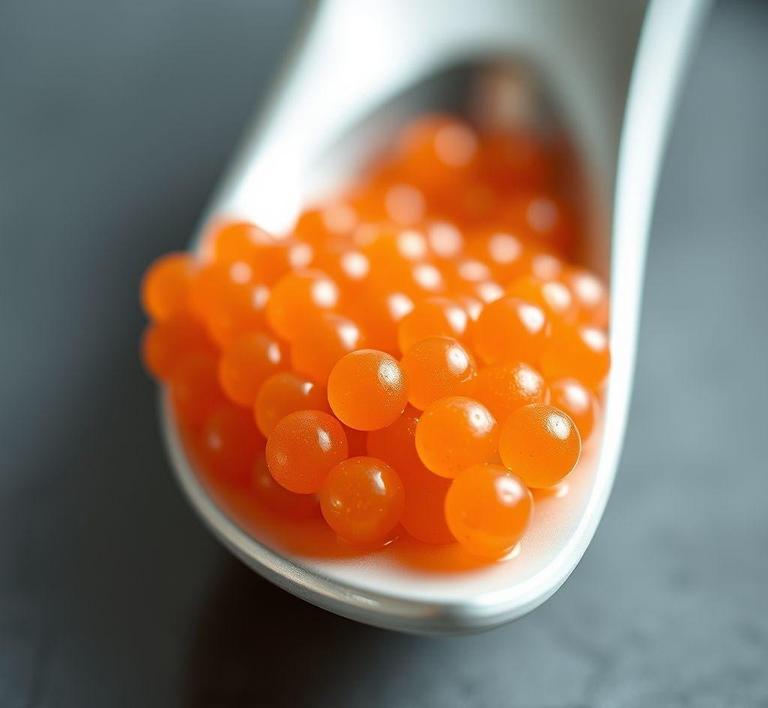If you’ve ever found yourself with leftover salmon roe after a special meal or a shopping spree, you might be wondering: Can I refreeze it? The good news is that yes, you can refreeze salmon roe, but there are some important things to keep in mind to ensure its quality stays top-notch. Salmon roe, also known as fish eggs, can be a delicate treat that’s all about texture and flavor. Freezing it properly and refreezing it at the right time can help preserve those qualities. In this guide, we’ll walk you through the steps to safely refreeze salmon roe while maintaining its deliciousness and ensuring it’s safe to eat later on!
Can You Refreeze Salmon Roe?

Salmon roe, also known as ikura in Japanese cuisine, is prized for its delicate texture, briny flavor, and vibrant orange pearls. Given its luxury status and the care required in handling, the question of whether you can refreeze salmon roe is a common concern among home cooks and seafood aficionados alike.
The simple answer is yes, you technically can refreeze salmon roe, but with important caveats that affect safety and quality. Salmon roe is a highly perishable seafood product. It is rich in oils and delicate membranes that encase each egg, making it vulnerable to degradation from temperature fluctuations. When salmon roe is frozen, ice crystals form inside the eggs. Thawing causes those ice crystals to melt and can rupture the eggs’ fragile membranes, resulting in a softer texture and potential leakage of brine or oils.
Refreezing compounds this issue. Each cycle of freezing and thawing increases the likelihood of membrane damage, microbial growth (if not handled properly), and overall quality loss. From a food safety perspective, as long as the roe has been thawed properly in the refrigerator and has not sat at room temperature for extended periods, it is safe to refreeze. However, if it was thawed improperly or has an off smell or appearance, refreezing is ill-advised.
In summary, while it’s possible to refreeze salmon roe, it’s generally not recommended unless you have no other choice. The resulting decline in texture, flavor, and appearance can diminish the luxurious experience of this delicacy.
How To Refreeze Salmon Roe?
If you decide to refreeze salmon roe, careful handling is paramount to preserve as much quality and safety as possible. Here’s a step-by-step guide on how to do it properly:
- Inspect the Roe Thoroughly: Before refreezing, check for any signs of spoilage such as sour or ammonia-like odors, discoloration, excessive liquid, or a slimy texture. If any of these are present, discard the roe.
- Keep It Cold: Salmon roe should be kept cold at all times. When thawing initially, do so in the refrigerator rather than at room temperature. This slows bacterial growth and preserves freshness. Only refreeze if it has stayed below 40°F (4°C) and hasn’t been out for more than 24 hours.
- Drain Excess Liquid: Gently drain any brine or liquid that may have accumulated during thawing. Excess moisture can promote freezer burn or ice crystal formation.
- Use Airtight Packaging: Transfer the roe to a vacuum-sealed bag or an airtight, freezer-safe container. Removing air is crucial to minimize freezer burn and oxidation, which deteriorate texture and flavor.
- Freeze Quickly: Place the container in the coldest part of your freezer. The faster the roe freezes, the smaller the ice crystals that form, helping to preserve the eggs’ membranes.
- Label and Date: Always label the package with the date of refreezing. Try to use the roe within a month of refreezing for best quality.
- Thaw Gently: When ready to use, thaw the roe slowly in the refrigerator to minimize membrane damage and leakage.
By following these steps, you can mitigate some of the inevitable quality loss and ensure the roe remains safe to eat.
Quality Impact
Refreezing salmon roe will almost certainly impact its quality – but to what extent depends on multiple factors including the initial freshness, freezing method, and handling.
- Texture: The biggest victim of refreezing is texture. The delicate eggs may become mushy or ‘puffed up’ with liquid seepage due to membrane rupture. Instead of popping crisply, the roe can feel soggy or slimy.
- Flavor: The subtle briny sweetness that characterizes high-quality ikura can be muted or altered after refreezing. Oxidation and moisture loss during thaw/refreeze cycles can introduce off-flavors or a stale taste.
- Appearance: The visual appeal of vibrant, glistening eggs may diminish. You might notice dullness, discoloration, or clumping of the eggs.
- Shelf Life: Refrozen salmon roe has a significantly shorter shelf life once thawed again – usually a day or two – due to cumulative damage and microbial risk.
Despite these drawbacks, if you handle the roe carefully and consume it promptly after refreezing, the difference might be subtle enough that it remains enjoyable, especially in cooked or mixed dishes where texture is less critical.
In the delicate world of salmon roe, freshness is king. While it is possible to refreeze salmon roe safely, it should be done sparingly and with great care to avoid compromising the sensory qualities that make it so prized. Each freeze-thaw cycle weakens the eggs’ structure, impacting texture, flavor, and visual appeal.
If you find yourself needing to refreeze salmon roe, prioritize slow thawing in the refrigerator, airtight storage, and quick refreezing in the coldest freezer zones. Always inspect the roe for spoilage before refreezing and consume it quickly after the second thaw.
Ultimately, for the best culinary experience, it’s ideal to only thaw the amount you intend to use and avoid refreezing whenever possible. When handled properly, salmon roe can still deliver its exquisite burst of ocean flavor – a true delight on sushi, blinis, or as a luxurious garnish.
Is It Safe To Refreeze Salmon Roe?
Salmon roe, also known as ikura, is a delicacy prized for its rich, briny flavor and vibrant orange pearls. Like many seafood products, proper storage is crucial to maintain its freshness, texture, and safety. The question of whether salmon roe can be safely refrozen is more complex than a simple yes or no.
When salmon roe is initially frozen and then thawed properly in the refrigerator, refreezing can be safe-but only under very specific conditions. The key lies in how the roe was thawed, how long it has been thawed, and how it has been handled since. If thawed slowly at refrigerator temperatures (below 40°F/4°C) and consumed or refrozen within a day or two, the risk of bacterial growth or spoilage is minimal.
However, if the roe was thawed at room temperature, left out for several hours, or if it has developed off odors, slimy textures, or discoloration, refreezing it can pose serious food safety risks. Refreezing can trap bacteria or degrade quality further, leading to potential foodborne illness and a poor eating experience.
Another consideration is the delicate nature of salmon roe eggs. Each tiny orb is encased in a thin membrane that can easily burst, and freezing and thawing cycles tend to break down this membrane, leading to a watery texture and loss of that coveted ‘pop’ sensation on the palate. So, even if it’s safe from a microbial standpoint, refreezing often compromises texture and flavor.
Signs That Salmon Roe Should Not Be Refrozen
Identifying when salmon roe has passed the safe refreezing point is crucial. Here are some telltale signs:
- Off or Sour Odor: Fresh roe has a briny, ocean-like scent. If it smells sour, fishy in a bad way, or ammonia-like, it’s a red flag that bacteria or spoilage organisms are present.
- Slimy or Sticky Texture: While roe naturally has a soft texture, a slimy or tacky surface often indicates bacterial growth.
- Discoloration: Fresh salmon roe is a vibrant orange to reddish-orange. If the roe appears dull, brownish, or has patches of white or black mold, it should be discarded.
- Excessive Liquid: Some liquid around roe is normal, but if the container is filled with watery brine or the eggs seem mushy and falling apart, it means the roe is breaking down.
- Unpleasant Taste: If you have already tasted the roe and it has a bitter or metallic aftertaste, do not refreeze it.
If any of these signs are present, the salmon roe should be discarded. Refreezing at this stage not only wastes the quality but poses health risks.
Common Refreezing Mistakes
Many people unintentionally make mistakes when handling salmon roe, leading to degradation or health risks:
- Refreezing After Room-Temperature Thawing: Thawing salmon roe outside the fridge exposes it to unsafe temperatures (above 40°F/4°C), where bacteria multiply rapidly. Refreezing after this exposure doesn’t kill bacteria.
- Delaying Refreezing: Waiting too long after thawing to refreeze increases spoilage risk. Salmon roe is highly perishable and should ideally be refrozen or consumed within 24-48 hours of thawing.
- Using the Same Packaging: If the original packaging has been opened and exposed to air, moisture, or contaminants, simply re-sealing and refreezing won’t protect the roe. Air exposure promotes freezer burn and bacterial growth.
- Not Using Airtight Containers: Exposure to air in the freezer causes dehydration and freezer burn, ruining texture and flavor.
- Freezing and Thawing Multiple Times: Each freeze-thaw cycle damages the delicate egg membranes, causing the roe to become mushy and watery, diminishing the sensory experience.
Tips And Tricks For Handling Salmon Roe And Refreezing
If you want to maximize the safety and enjoyment of your salmon roe, here are some essential tips:
- Thaw Slowly in the Fridge: Always thaw frozen roe in the refrigerator, ideally in its original packaging or a sealed airtight container. This keeps it cold and reduces bacterial growth.
- Use Airtight, Vacuum-Sealed Packaging: To preserve freshness and prevent freezer burn, store roe in vacuum-sealed bags or airtight containers. This is especially important if you plan to refreeze.
- Label with Dates: Always label your containers with freeze and thaw dates to track how long the roe has been stored.
- Consume Quickly After Thawing: For optimal flavor and safety, consume thawed roe within 24-48 hours.
- Avoid Multiple Freeze-Thaw Cycles: Only thaw what you plan to use. Portioning roe into small containers before freezing can help avoid wastage and unnecessary refreezing.
- Keep Temperatures Consistent: Maintain your freezer at 0°F (-18°C) or below for safe long-term storage, and your fridge at or below 40°F (4°C) when thawing.
- Inspect Before Refreezing: Always check the roe for signs of spoilage before deciding to refreeze.
Conclusion
In essence, while refreezing salmon roe can be safe if handled with care, it’s generally best avoided due to the delicate nature of the eggs and the potential for quality loss and food safety risks. Understanding the right thawing methods, recognizing spoilage signs, and practicing proper storage can help you enjoy salmon roe at its best. When in doubt, it’s safer and more pleasurable to consume roe fresh or after a single thaw rather than risking texture, flavor, and your health through repeated refreezing.


